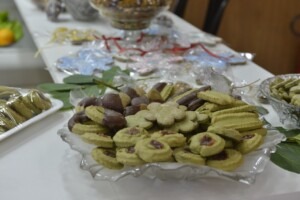Almost 20 years ago, Ludmila Gallon took the National Rural Learning Service’s (SENAR) course about yerba mate and was delighted. It all happened after she moved to Ilópolis, a city known for the plant’s high level of production. Its name derives from “Ilex paraguariensis” (the scientific name of yerba mate), and “polis” (“city,” in Greek); in other words, Ilópolis is Yerba Mate’s City.
 What caught Ludmilla’s attention were the aspects of the herb, which is so usual in the daily lives of the inhabitants of the Brazilian southern, and countries such as Argentina, Paraguay, and Uruguay. The medicinal plant has been highly consumed in the region since the 16th century, as an infusion of the leaves in hot water called “chimarrão”; another infusion prepared with cold water is called “tererê.”
What caught Ludmilla’s attention were the aspects of the herb, which is so usual in the daily lives of the inhabitants of the Brazilian southern, and countries such as Argentina, Paraguay, and Uruguay. The medicinal plant has been highly consumed in the region since the 16th century, as an infusion of the leaves in hot water called “chimarrão”; another infusion prepared with cold water is called “tererê.”
Yerba mate contains considerable amounts of caffeine, saponins, polyphenols, xanthines, theophylline, theobromine, folic acid, tannins, minerals, and vitamins: A, B1, B2, C, and E. Therefore, it functions as an antioxidant, diuretic, laxative, stimulant, antidiabetic, antiobesity, antibacterial, antifungal, and hypocholesterolemic; it also improves the digestive process.
“It is a South American cultural and genetic heritage that the rest of the world must know,” says Ludmila. Since that first course, in 2003, she has dedicated herself to studying the plant and applying this knowledge to nutritious and tasty recipes, which are already famous in the region. “The SENAR course was about medicinal plants. When I learned about yerba mate’s importance, I was delighted and began to think of recipes including it,” says Ludmila.
The first experiments were done with fresh leaves, making a juice mixed with lemon. “Citric fruits go very well with mate, making a very refreshing drink while preserving its medicinal aspects,” she explains. With the knowledge obtained in the course and personal dedication, Ludmilla began to apply sifted dried leaves to prepare flour to strengthen and flavor new recipes. Cakes, bread, and cookies prepared with yerba mate gain extra nutrients and have a unique flavor.

Before devoting her studies to the application of yerba mate in food, Ludmila worked in rural extension at EMATER in Rio Grande do Sul state for 26 years, focusing on helping rural producers. Today, she is also a nutrition assistant and works with pedagogy and environmental education. Together with local universities and support from EMBRAPA, she intends to enhance her studies by forming a scientific base. “I study a lot in theory and practice. I have a seedling production and I think of developing new products that bring improvements to the food sector,” she explains.
Ludmila believes in the potential of spreading knowledge throughout Brazil and the world, also with a social outlook. “We want to include yerba mate in school meals, to bring these nutrients to form the base of the diet,” she says. Currently, she teaches courses and workshops demonstrating the recipes, both for cooking professionals and children and young people.

Tasting yerba mate
Ilópolis is located in the yerba mate south Brazilian producing pole. The city is the headquarters of IBRAMATE, which gather dozens of producers and associations representing five producing zones, to organize and improve the production chain.
According to the Brazilian Institute of Geography and Statistics (IBGE), Brazil produced more than 527 thousand tons of yerba mate in 2020, 520 thousand tons in the South region alone. The states that stand out the most are Rio Grande do Sul, Santa Catarina, Paraná, and Mato Grosso do Sul—the last one, in the Midwest region.
The plant is indeed a Brazilian favorite. Iced tea, usually prepared with sugar and lemon juice, is popular on the beaches of Rio de Janeiro. “Cariocas”—as those born in Rio are known in the country—drink toasted yerba mate. The drink became so ingrained in the beach culture that, in 2012, it was appointed as an Intangible Cultural Heritage of the city.
When ready to drink as chimarrão or ice tea, yerba mate may differ in color, texture, and taste. The final product varies from different harvests, and by the temperature of the water used. However, in general terms, yerba mate is light and fresh, with some bitter and toasted flavor.
For high-quality production, Ludmila uses young leaves of plants grown in the shade in integrated systems with native forests, common in the Paraná state. She selects the younger organic leaves, that later are dried and sieved. Here are two of her favorite recipes:
Refreshing juice with mate leaves
Ingredients:
4 to 5 well-washed green yerba mate leaves
1 cup of sugar (70 to 80 g)
1 liter of cold water, juice of 2 lemons
How to prepare:
Pour 500 ml of water into a blender, together with the yerba mate leaves, and sugar or honey. Mix well and strain it. Add the rest of the water and the lemon juice. Enjoy it!
Cake with mate tea
Ingredients:
4 eggs
1 cup of orange juice, 2 cups of sugar
3 tablespoons of powdered yerba mate
Lemon (Galician or Sicilian) zest
1 pinch of salt,
1/2 cup of corn or sunflower oil
2 1/2 cups of flour
1 1/2 tablespoons of baking powder
How to prepare:
Separate the egg whites from the yolks. Mix the egg whites with 1 cup of sugar and set it aside. Pour the egg yolks, 1 cup of sugar, yerba mate powder, salt, and oil into a blender, mixing it well. Place the dough in a bowl and add sifted flour and baking powder. Pour it into a greased and floured cake pan. Bake it in a preheated oven at 180°C for 40 minutes.